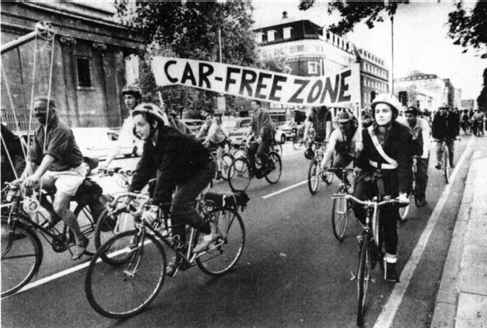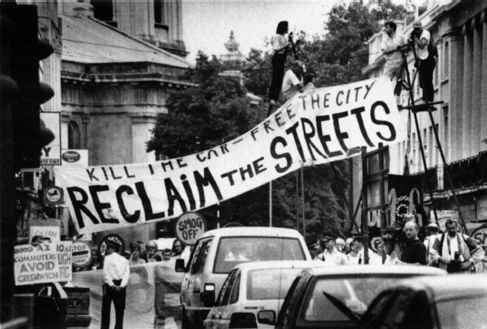

Making it happen doesn't require centralised organisation or leaders. Just talk to likely people. Pick a safe car-free meeting space in a central location, set a regular convenient time (e.g. 5.30 pm on the last Friday of every month) and then make some fliers. Hand these out to passing cyclists, flypost them, put them in cycle shops and on notice boards. Don't include names of individuals, groups or any telephone numbers on the flier.
On the day, anybody can suggest a route. Be ready to adapt and keep together, even if that involves those at the back going through a red light. If there are only five of you don't try to take up the whole road as this will be too risky. The police may ask who is in charge. The correct answer is - NOBODY. Most encounters with car drivers should be friendly, don't forget to wear a smile. Have leaflets printed up to give out to pedestrians and drivers explaining what is going on.
At traffic lights and junctions, outriders, sometimes known as "corkers", can block waiting cars so that drivers won't be tempted to drive into the critical mass. When you meet the odd nutter, you'll usually do better with a sense of humour and proportion than a hostile attitude. Whatever you do, have fun and enjoy the calm created by lots of push bikes and bells. For more information see Critical Mass: How To (see Chapter xx), and have a browse through the World Wide Website - http://www.ph.ed.ac.uk/~jonivar/greens/cm.html
Blockading groups -
These groups quickly put a section of the blockade in place. Only one person
in each blockading group needs to know the location, and groups don't need to
know what the others are doing. They need to liaise with their support group,
and should acquire and store their equipment in advance. There are many
different ways of blocking a road to traffic. For example, you could stage a
mock car crash, erect scaffolding tripods, hold a critical mass or a
pedestrian procession carrying banners. These tactics will work if the
blockade is quick and unexpected. Other ideas might include street theatre,
redirecting traffic with mock road signs or groups of people continuously
walking across zebra crossings. A combination of these, plus your own ideas,
should establish a temporary blockade.
Blockading support groups -
These groups reinforce the initial blockade. They assemble somewhere else,
waiting for a signal from the blockading group, before moving quickly to the
location. The police are likely to be monitoring support groups.
Traffic redirectors -
Deal with traffic until the police arrive. Explain what is happening, suggest
alternative routes and invite motorists to join in.
Guides -
When the blockade is in place, making the party a success relies on getting a
large number of people there quickly from the publicised meeting place. The
meeting point should be a public space from which a large number of people can
move relatively quickly to the target location, either on foot or by public
transport. Guides should be easily identifiable and their identifying feature
must be networked through the crowd at the last minute. For example, a legal
briefing leaflet distributed at the meeting place could also include a message
saying something like, "Follow the people in wigs, holding helium-filled
balloons".
Press liaison -
It may be worth setting a time and place to meet the media. Press releases
should NOT include the location of the Street Party even if you embargo
it.
Police liaison -
This is optional. One person could take on the role of approaching the police
to give them just enough information to keep them off your back. Don't tell
them anything useful, especially the secret location. If they think they know
what is going on, then they are less likely to over-react. For example, give
them a finish time and tell them that there will be an army of litter pickers.
Use a false name. If you hear anyone saying too much, step in and chat about
the weather.

Information leaflets will help to spread the message of what the party is about. Separate, appropriately styled leaflets for pedestrians and motorists are ideal.
Organise some legal support to advise on the legal implications of the action and to take care of anyone arrested. Breach of the Peace and Obstruction of the Highway are the most likely charges if you block a road. Prepare bust cards and set up a team of action observers.
Now celebrate the car free space and show its possibilities. Groups can take on setting up a safe children's play area, sandpit, cafe, music (acoustic and amplified), banners between lamp-posts (for climbing them, see lamp-post prussiking in the Appendix), street decoration (eg. painting, tree planting), information stalls and theatre. These things can take up to two months to organise, as you have to book performers and persuade them to take part for free. Be sensitive to local residents - think about noise pollution and general disturbance.
Road Alert!
EMAIL: info@roadalert.org.uk